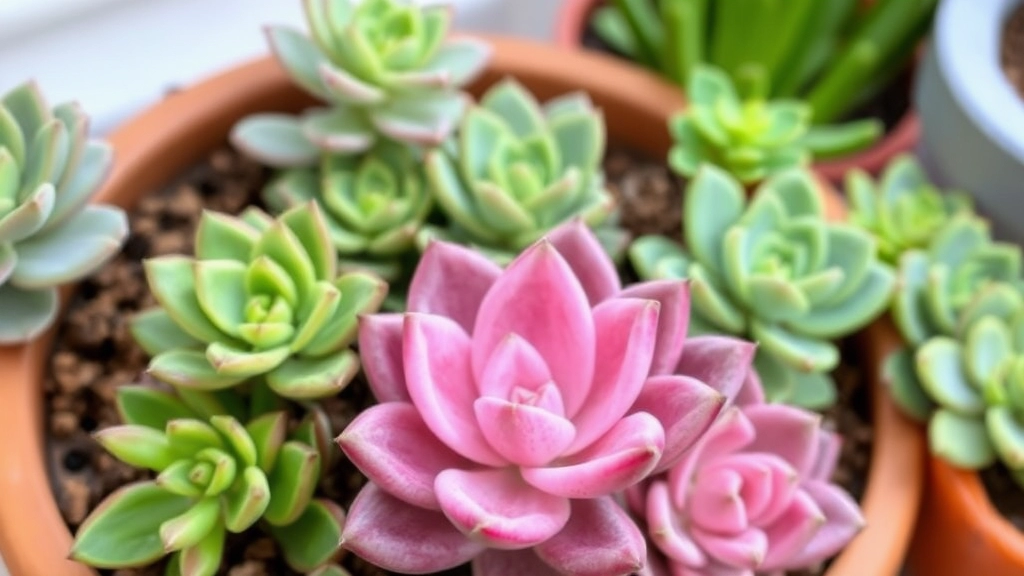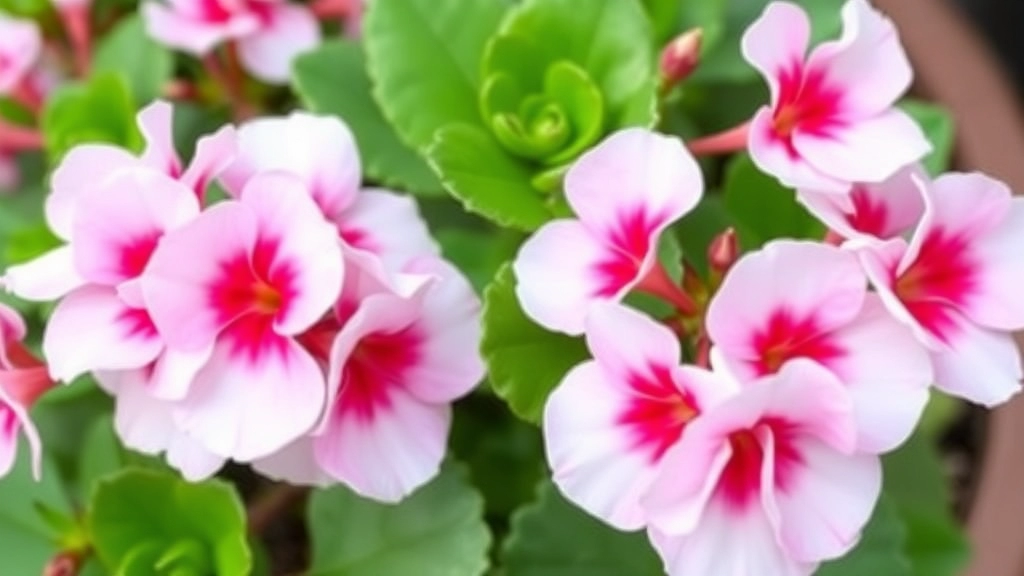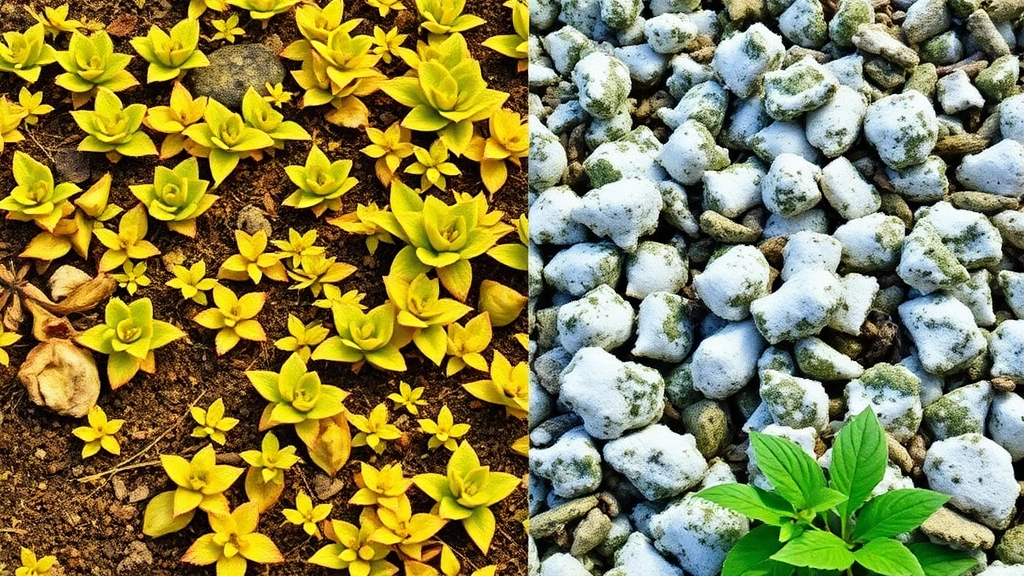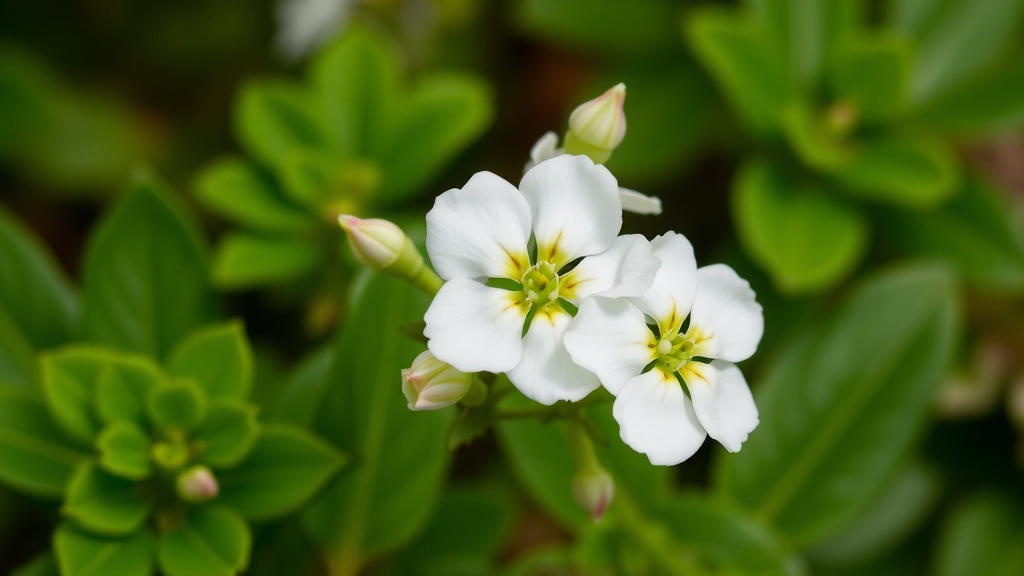Growing a Kalanchoe Flower White
Growing a Kalanchoe Flower White can be a delightful experience, especially if you love low-maintenance plants with vibrant blooms. These succulent beauties thrive in bright, indirect light and well-draining soil, making them perfect for both indoor and outdoor spaces. Ensuring your Kalanchoe gets the right amount of water is key—let the soil dry out between waterings to prevent root rot.
Care Tips
To keep your white Kalanchoe blooming, occasional pruning and deadheading are essential. This not only promotes continuous flowering but also keeps the plant looking fresh. If you’re interested in propagating, stem cuttings are a straightforward way to multiply your collection. With minimal effort, you can enjoy these stunning white flowers year-round, adding a touch of elegance to your home or garden.
Are you struggling to get your white Kalanchoe flowers to thrive? You’re not alone. Many plant enthusiasts face challenges when it comes to creating the perfect environment for these stunning succulents.
## Light Requirements
White Kalanchoe flowers flourish in bright, indirect sunlight.
– **Optimal Location:** Place your plant near a window that receives morning sun but is shaded from harsh afternoon rays.
– **Signs of Insufficient Light:** If your Kalanchoe becomes leggy or the leaves start to yellow, it’s likely craving more light.
## Temperature and Humidity
Temperature plays a crucial role in the health of your Kalanchoe.
– **Ideal Temperature:** Aim for a range between 18°C and 24°C.
– **Humidity Levels:** These succulents prefer lower humidity, so avoid overly damp environments.
## Air Circulation
Good air circulation is vital for preventing diseases.
– **Ventilation:** Ensure your plant has space around it for air to flow. This helps keep the leaves dry and healthy.
## Fertilization
A little extra nutrition can go a long way.
– **Fertilizer Type:** Use a balanced, water-soluble fertilizer during the growing season, typically spring and summer.
– **Frequency:** Feed every four to six weeks, but avoid over-fertilizing as it can harm your plant.
For more detailed care tips, you might find our [ultimate guide to growing Kalanchoe pink flowers](https://planthq.org/ultimate-guide-to-growing-kalanchoe-pink-flowers/) very useful. Additionally, if you’re interested in other Kalanchoe varieties, check out our [top Kalanchoe succulents with red flowers care tips](https://planthq.org/top-kalanchoe-succulents-with-red-flowers-care-tips-varieties/).
Watering Needs for Kalanchoe Succulents

So, you’ve got your stunning White Kalanchoe, and you’re wondering how to keep it thriving. One of the biggest worries for plant parents is getting the watering just right. Overwatering or underwatering can be a real problem, so let’s dive into how to keep your Kalanchoe happy and hydrated.
Understanding Kalanchoe’s Watering Needs
Kalanchoe succulents are pretty forgiving, but they do have their quirks. Here’s what you need to know:
- Soil Check: Always check if the soil is dry before watering. Stick your finger about an inch into the soil. If it feels dry, it’s time to water.
- Watering Frequency: Generally, water every 2-3 weeks. In the summer, they might need a bit more love, while in winter, you can cut back to once a month.
- Watering Method: Water thoroughly until it drains out of the bottom. This ensures the roots get enough moisture. Just remember to empty any excess water from the saucer—Kalanchoes don’t like soggy feet!
- Signs of Trouble: Yellowing leaves or mushy stems? That’s a red flag for overwatering. Conversely, if the leaves are shrivelling, it’s time to up your watering game.
Tips for Perfect Watering
- Use Room Temperature Water: Cold water can shock your plant. Always use water that’s at room temperature.
- Consider Humidity: In dry environments, you might need to adjust your watering schedule. A little humidity can go a long way!
- Seasonal Adjustments: During the growing season (spring and summer), your Kalanchoe will be thirstier. In fall and winter, let it rest a bit.
Best Potting Soil for Healthy Kalanchoe Growth
When considering the ideal potting soil for your White Kalanchoe, it’s essential to understand that these succulents thrive in specific soil conditions.
What Should the Soil Be Like?
- Well-Draining: Kalanchoes require soil that allows excess water to escape quickly. This helps prevent root rot, a common issue for these plants.
- Lightweight Mix: A mix that is not too dense will provide the necessary aeration for healthy root development.
- pH Level: Aim for a slightly acidic to neutral pH, ideally between 6.0 and 7.0.
Recommended Soil Mixes
- Cactus Mix: A pre-packaged cactus potting mix often works well, as it is designed for excellent drainage.
- DIY Mix: You can create your own by combining:
- 2 parts potting soil
- 1 part perlite or coarse sand
- 1 part orchid bark
Why This Matters
Using the right potting soil is crucial for your Kalanchoe’s overall health. The proper mix supports robust root systems, which in turn leads to vibrant blooms and lush foliage.
Tips for Potting
- Choose the Right Pot: Ensure your pot has drainage holes to facilitate water escape.
- Repotting: Consider repotting every couple of years to refresh the soil and accommodate growth. For more detailed guidance, check out our Florist Kalanchoe Propagation Guide.
For further insights on maintaining your Kalanchoe, you might find our guide on causes and fixes for drying Kalanchoe leaves particularly helpful.
How to Promote Blooming in White Kalanchoe Plants

When it comes to encouraging your White Kalanchoe to bloom, many of us often wonder what steps we can take to ensure a vibrant display of flowers.
Key Factors for Blooming
Here are several effective strategies to promote blooming in your White Kalanchoe plants:
- Light Exposure:
- Ensure your Kalanchoe receives bright, indirect sunlight.
- A south or west-facing window is ideal.
- Too much direct sunlight can scorch the leaves, while too little can hinder blooming.
- Temperature:
- Maintain a temperature range of 18-24°C (65-75°F).
- Kalanchoes thrive in warmth, but avoid extreme heat or cold drafts.
- Watering Routine:
- Water your plant only when the soil is dry to the touch.
- Overwatering can lead to root rot, which stunts blooming.
- Fertilisation:
- Use a balanced, water-soluble fertiliser every 4-6 weeks during the growing season.
- A fertiliser high in phosphorus can encourage more blooms.
- Pruning:
- After the flowering period, prune back spent flowers and any leggy growth.
- This encourages new growth and can result in more blooms.
- Dormancy Period:
- Allow your Kalanchoe a rest period after blooming.
- Reduce watering and stop fertilising for about 6-8 weeks.
- This helps the plant conserve energy for the next blooming cycle.
Pruning and Deadheading for Continuous Flowers
Maintaining the vibrancy of your white Kalanchoe plants requires proper care, particularly through pruning and deadheading. You might be wondering how to keep those beautiful blooms coming back season after season.
Why Pruning Matters
Pruning is essential for promoting healthy growth and encouraging more flowers. By removing spent blooms and shaping the plant, you create an environment that supports continuous flowering.
Steps for Pruning White Kalanchoe:
- Timing: Prune after the blooming period, usually in late spring or early summer.
- Tools: Use clean, sharp scissors or pruning shears to avoid damaging the plant.
- Technique:
- Remove dead or wilted flowers by cutting them off at the base.
- Trim back any leggy stems to encourage bushier growth.
- Aim to keep the plant’s shape balanced and aesthetically pleasing.
Deadheading for More Blooms
Deadheading is the process of removing spent flowers to encourage new growth. It’s a simple yet effective way to keep your Kalanchoe looking fresh.
- How to Deadhead:
- Identify wilted flowers.
- Pinch or cut them off at the base of the stem.
- Check for any leaves that may also need trimming.
Benefits of Pruning and Deadheading:
- Encourages new flower production.
- Improves air circulation around the plant.
- Maintains a tidy appearance.
By incorporating these practices, you’ll not only enhance the beauty of your white Kalanchoe but also promote its overall health. For more detailed care tips, check out our indoor vs outdoor care guide for Kalanchoe Blossfeldiana. Additionally, learn about the causes and treatments for white spots on Kalanchoe Tomentosa to keep your plants healthy.
VI. Propagating White Kalanchoe from Stem Cuttings
Ever found yourself admiring your White Kalanchoe and thought, “I wish I could have more of these beauties”? You’re not alone! Propagating Kalanchoe from stem cuttings is a fantastic way to expand your collection without breaking the bank.
Why Propagate?
- Cost-effective: Instead of buying new plants, you can create your own.
- Personal Touch: Each new plant carries a bit of your gardening spirit.
- Fun Project: It’s a rewarding experience to see your cuttings grow.
Steps to Propagate White Kalanchoe
- Choose Healthy Stems: Look for plump, healthy stems. Avoid any that are damaged or diseased.
- Make the Cut: Use clean, sharp scissors to snip a stem about 4-6 inches long. Cut just below a leaf node for the best chance of growth.
- Let it Callous: Place the cutting in a dry, warm spot for a few days. This helps the cut end to callous over, reducing the risk of rot.
- Prepare the Soil: Use well-draining potting soil. A mix specifically for succulents works wonders.
- Plant the Cutting: Once the end has calloused, plant it about an inch deep into the soil.
- Water Sparingly: Give it a light misting but avoid soaking. Too much water can lead to rot.
- Provide Bright Indirect Light: Place your pot in a spot with bright, indirect sunlight. Too much direct sun can stress the cutting.
- Be Patient: It can take a few weeks for roots to develop. Just keep an eye on it and resist the urge to fuss too much!
Signs of Success
- New leaves sprouting.
- A slight resistance when you gently tug on the cutting.
As we delve deeper into caring for your White Kalanchoe, it’s essential to be aware of the common pests and diseases that can threaten its health.
### Pests to Watch For:
– **Aphids**
– Small, green or black insects that suck sap from the plant.
– Signs include curled leaves and sticky residue.
– **Mealybugs**
– White, cotton-like clusters on stems and leaves.
– They can cause yellowing and stunted growth.
– **Spider Mites**
– Tiny, spider-like creatures that thrive in dry conditions.
– Look for fine webbing and speckled leaves.
– **Scale Insects**
– Small, round bumps on stems and leaves.
– They can weaken the plant significantly.
### Diseases to Consider:
– **Root Rot**
– Caused by overwatering and poorly draining soil.
– Symptoms include wilting and blackened roots.
– **Powdery Mildew**
– A white powdery fungus that appears on leaves.
– It thrives in humid conditions and can be controlled with proper air circulation.
### Preventative Measures:
– **Regular Inspection:** Check your plants weekly for signs of pests or disease.
– **Proper Watering:** Ensure the soil dries out between waterings to prevent root rot.
– **Good Airflow:** Space plants adequately to reduce humidity levels that encourage mildew.
For more detailed care tips, you might find our [Florist Kalanchoe Common Names and Care Guide](https://planthq.org/florist-kalanchoe-common-names-and-care-guide/) and [How to Care for a Kalanchoe Succulent: Expert Tips](https://planthq.org/how-to-care-for-a-kalanchoe-succulent-expert-tips/) particularly useful.
Seasonal Care: Adjusting for Winter and Summer Growth

So, you’ve got your beautiful White Kalanchoe, and now you’re wondering how to keep it thriving through the changing seasons.
Winter Care:
During winter, your Kalanchoe needs a bit of extra TLC. Here’s what to keep in mind:
- Light: Place it in a bright spot, but avoid harsh direct sunlight.
- Temperature: Keep it in a warm area, ideally between 15-20°C. Cold drafts are a no-go!
- Watering: Scale back on watering. Allow the soil to dry out between waterings. Too much moisture can lead to root rot.
- Humidity: Kalanchoes prefer low humidity, so don’t worry about misting.
Summer Care:
When summer rolls around, your Kalanchoe will want to soak up the sun. Here’s how to adjust:
- Light: Aim for bright, indirect light. Direct sunlight can scorch the leaves.
- Temperature: They love warmth, so keep them in a cozy spot, but ensure it doesn’t exceed 30°C.
- Watering: Increase watering frequency, allowing the top inch of soil to dry out.
- Fertilising: Consider a diluted succulent fertilizer every few weeks to support growth.
General Tips:
- Check for Pests: Seasons change, and so do pests! Keep an eye out for any unwanted guests, especially in warmer months.
- Repotting: Spring is an ideal time to repot if your Kalanchoe has outgrown its pot.
White Kalanchoe flowers are not just beautiful; they also serve multiple decorative purposes that can enhance any space.
### Indoor Uses
– **Table Centerpieces**
A vibrant White Kalanchoe can serve as an eye-catching centerpiece on dining or coffee tables. Pair it with contrasting tableware for a striking look.
– **Windowsills**
Place these succulents on windowsills where they can soak up sunlight. Their bright blooms can add a cheerful touch to your indoor environment.
– **Shelving Units**
Group White Kalanchoe plants on shelves with varying heights. This creates visual interest and brings life to otherwise dull areas.
– **Office Spaces**
Incorporate these plants into your workspace. They can boost your mood and productivity while adding a touch of nature.
### Outdoor Uses
– **Patio Planters**
Use White Kalanchoe in decorative pots on your patio. Their resilience makes them perfect for outdoor settings.
– **Garden Borders**
Plant them along garden borders for a splash of colour. They can create a beautiful contrast against green foliage.
– **Hanging Baskets**
Consider using them in hanging baskets. Their cascading blooms can create a stunning visual effect.
– **Event Decor**
White Kalanchoe can also be used for special occasions. They make excellent additions to [wedding centrepieces](https://planthq.org/kalanchoe-flower-meaning-symbolism-uses-cultural-significance/) or [party decorations](https://planthq.org/vibrant-kalanchoe-blossfeldiana-colors-a-complete-guide/).
FAQs on Caring for White Kalanchoe Flowers
How often should I water my White Kalanchoe?
Generally, you should water your White Kalanchoe every 2-3 weeks. In summer, they might need more frequent watering, while in winter, you can cut back to once a month. Always check if the soil is dry before watering.
What type of light does a White Kalanchoe need?
Kalanchoe plants thrive in bright, indirect sunlight. A south or west-facing window is ideal. Too much direct sunlight can scorch the leaves, while too little light can hinder blooming.
What temperature is best for White Kalanchoe?
Maintain a temperature range of 18-24°C (65-75°F). Kalanchoes thrive in warmth but avoid extreme heat or cold drafts.
How do I promote blooming in my White Kalanchoe?
To promote blooming, ensure your Kalanchoe gets bright, indirect light, maintain the right temperature, water only when the soil is dry, and fertilize with a balanced, water-soluble fertilizer every 4-6 weeks during the growing season.
Can I propagate White Kalanchoe from stem cuttings?
Yes, propagating White Kalanchoe from stem cuttings is a cost-effective and rewarding way to expand your collection. Choose healthy stems, let the cut end callous over, plant in well-draining soil, and provide bright indirect light.
What are the signs of overwatering and underwatering?
Yellowing leaves or mushy stems indicate overwatering, while shriveling leaves suggest underwatering. Adjust your watering routine accordingly.
How should I adjust care for my White Kalanchoe in winter?
In winter, place your Kalanchoe in a bright spot but avoid harsh direct sunlight. Keep it in a warm area (15-20°C) and scale back on watering, allowing the soil to dry out between waterings.
What are the summer care tips for White Kalanchoe?
During summer, ensure your Kalanchoe gets bright, indirect light and keep it in a warm spot without exceeding 30°C. Increase watering frequency and consider using a diluted succulent fertilizer every few weeks.
How can I tell if my propagated Kalanchoe cutting is successful?
Signs of successful propagation include new leaves sprouting and a slight resistance when you gently tug on the cutting.
Should I repot my White Kalanchoe, and when?
Spring is an ideal time to repot your Kalanchoe if it has outgrown its pot. This allows for fresh soil and more room for growth.
References
-
Guide to Watering Kalanchoe Succulents
-
Tips for Promoting Blooming in Kalanchoe Plants
-
How to Propagate Kalanchoe from Stem Cuttings
